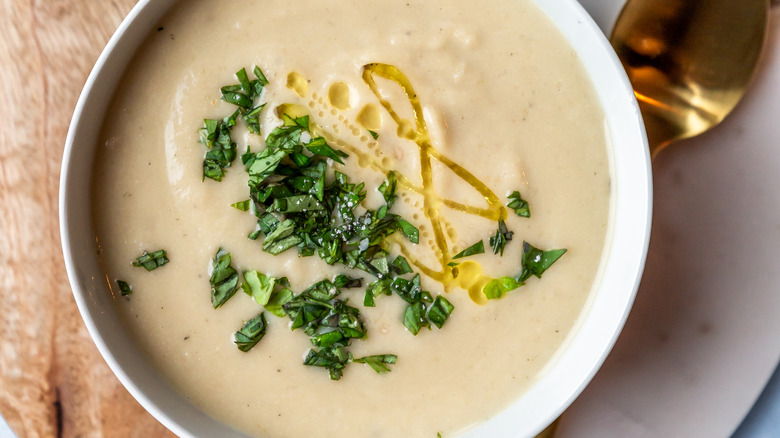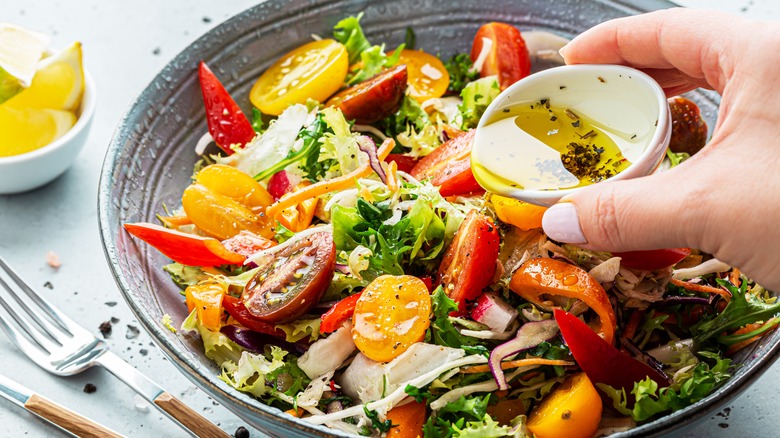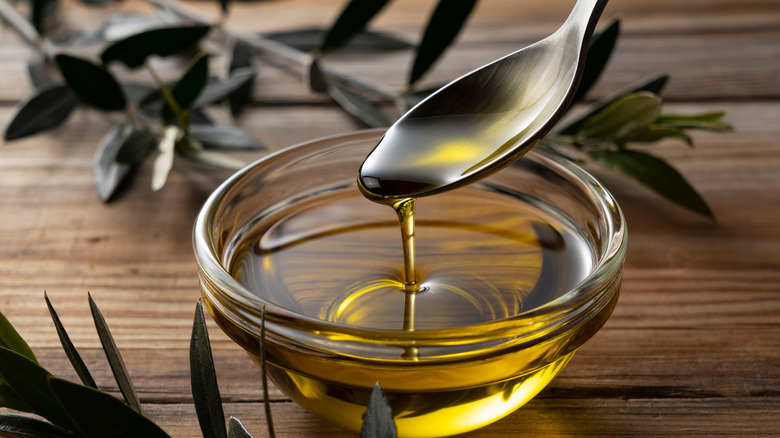The Olive Oil Trick Restaurant Chefs Use To Elevate Dinner Plates
Olive oil is good stuff. Really good stuff. In fact, Britannica writes that most of the oil is made in (and also, exported from) Greece, Italy, Spain, and Tunisia. It's also made in some other areas where the climate conditions are good for olive trees, like South America, Australia, and California. The Culinary Institute of America (via the North American Olive Oil Association) stands behind olive oil as a healthful, sustainable, plant-based cooking oil that's suitable for all cooking techniques, despite the common misconception to the contrary.
But low heat is what's needed to appreciate the delicate nature of extra virgin olive oil. According to Britannica, pure olive oil is used generally for cooking and preserving, including those tins of fish you see packaged in olive oil — with additional applications in other, less edible industries. North American Olive Oil Association adds that top-shelf extra virgin olive oils, with high price tags and concentrations of subtle fragrances and flavors, are better off for uncooked applications (think salad dressing), or to drizzle on top of a dish once it's done. In that regard, if you've got a bottle of nice olive oil in your kitchen, you can add a simple, elegant touch to just about anything you make.
How to finish a dish with olive oil
In an article by Stylecaster, Sydney Willcox, culinary instructor at The Brooklyn Kitchen, says "Take a note from Mediterranean dwellers and finish your dishes with a little drizzle of high-quality extra-virgin olive oil; it will make for a silky finish!" Finishing oils enhance appearance, taste, and texture, and recommends beginning with a quality extra virgin olive oil over a simple Caprese salad (via Martha Stewart), or perhaps adding some to fruit, too.
Kohlmeyer also tries olive oil out on just a little bit of each finished dish first and drizzles away if the results are successful. A separate Martha Stewart article explains that while a cruet (oil dispenser bottle, often with a spout) might make finishing with olive oil easier, it might compromise the delicate oil within. Instead, keep the oil in its original bottle, away from sources of light and heat (including your stovetop). SFGATE says that you can also spoon olive oil onto your food from a bowl, or use your thumb over the mouth of the bottle to allow just a trickle to issue forth.
More reasons to put olive oil on everything
Healthline reports that olive oil mostly contains monounsaturated fat (oleic acid), giving it its anti-inflammatory effects and other possible health benefits. It also has some saturated fat and polyunsaturated fats including the fatty acids omega-3 and omega-6, along with antioxidants and polyphenols (per National Library of Medicine via International Journal of Molecular Sciences). Versatile olive oil is also the main source of fat in the Mediterranean diet, which research has revealed to curb many health conditions including heart disease, cancer, asthma, allergies, and obesity (per NLM via Nutrients).
NLM further writes that "MedDiets" emphasize fruits, vegetables, whole grains, starches, seeds, and nuts — a so-called plant-based diet. But you don't have to eat a "MedDiet" to enjoy olive oil. The OliveTap writes that olive oil can help restore the flavors and moisture in lean meats like non-marbled steak, chicken breast, pork, and veal. It improves the eating experience of these foods and provides a "finishing touch" for popcorn, pizza, rice dishes, and more, The OliveTap adds. Use olive oil in place of butter, work it into ice cream and other desserts, or enrich your pasta preparations with it. The possibilities are endless, and so are the benefits — try adding olive oil to your next dish and experience it for yourself.


